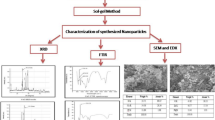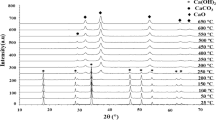Abstract
Copper monoxide (CuO) was successfully obtained by microwave-assisted hydrothermal method, using different conditions—in a solution without base, in a solution alkalinized with NaOH or with NH4OH. The powders were analyzed by thermal analysis (TG/DTA), X-ray diffraction (XRD), infrared spectroscopy, UV–Visible spectroscopy, and scanning electronic microscopy. XRD results showed that CuO was obtained with monoclinic structure and without secondary phases. Thermal analysis and infrared spectra indicated the presence of acetate groups on the powder surface. TG curves also showed a mass gain assigned to the Cu(I) oxidation indicating that a reduction possibly occurred during synthesis. The high and broad absorption band in the UV–Vis spectroscopy from 250 to 750 nm indicated the coexistence of Cu(II) and Cu(I), confirming the Cu(II) reduction, inside the CuO lattice. It was also possible to confirm the Cu(II) reduction by a displacement of the Me–O vibration bands observed in the IR spectra at around 500 cm−1.





Similar content being viewed by others
References
Han WK, Choi JW, Hwang GH, Hong SJ, Lee JS, Kang SG. Fabrication of Cu nanoparticles by direct electrochemical reduction from CuO nanoparticles. Appl Surf Sci. 2006;252:2832–8.
Zhang M, Xu X, Zhang M. Hydrothermal synthesis of sheaf-like CuO via ionic liquids. Mater Lett. 2008;62:385–8.
Wold A, Dwight K. Solid state chemistry: synthesis, structure and properties of selected oxides and sulfides. New York: Chapman & Hall; 1993.
Keyson D, Volanti DP, Cavalcante LS, Simões AZ, Varela JA, Longo E. A simple wet-chemical synthesis and characterization of CuO nanorods. Mater Res Bull. 2008;43:771–5.
Volanti DP, Keyson D, Cavalcante LS, Simões AZ, Joya MR, Longo E, Varela JA, Pizani PS, Souza AG. Synthesis and characterization of CuO flower-nanostructure processing by a domestic hydrothermal microwave. J Alloy Compd. 2008;459:537–42.
Xu X, Zhang M, Feng J, Zhang M. Shape-controlled synthesis of single-crystalline cupric oxide by microwave heating using an ionic liquid. Mater Lett. 2008;62:2787–90.
Wang WW, Zhu YJ, Cheng GF, Huang YH. Microwave-assisted synthesis of cupric oxide nanosheets and nanowhiskers. Mater Lett. 2006;60:609–12.
Wang H, Xu JZ, Zhu JJ, Chen HY. Preparation of CuO nanoparticles by microwave irradiation. J Cryst Growth. 2002;244:88–94.
Chang X, Ji G, Shen K, Pan L, Shi Y, Zheng Y. Fabrication of nanowire-like cuprous oxide in aqueous solutions of a triblock copolymer. J Alloy Compd. 2009;482:240–5.
Nagase K, Zheng Y, Kodama Y, Kakuta J. Dynamic study of the oxidation state of copper in the course of carbon monoxide oxidation over powdered CuO and Cu2O. J Catal. 1999;187:123–30.
Xu Y, Chen D, Jiao X. Fabrication of CuO pricky microspheres with tunable size by a simple solution route. J Phys Chem B. 2005;109:13561–6.
Lefez B, Souchet R, Kartouni K, Lenglet M. Infrared reflection study of CuO in thin oxide films. Thin Solid Films. 1995;268:45–8.
Zhu J, Chen H, Liu H, Yang X, Lu L, Wang X. Needle-shaped nanocrystalline CuO prepared by liquid hydrolysis of Cu(OAc)2. Mater Sci Eng A. 2004;384:172–6.
Qu Y, Li X, Chen G, Zhang H, Chen Y. Synthesis of Cu2O nano-whiskers by a novel wet-chemical route. Mater Lett. 2008;62:886–8.
Luo Z, Li H, Shu H, Wang K, Xia J, Yan Y. Synthesis of BaMoO4 nestlike nanostructures under a new growth mechanism. Cryst Growth Des. 2008;8:2275–81.
Min Y, Wang T, Chen Y. Microwave-assistant synthesis of ordered CuO micro-structures on Cu substrate. Appl Surf Sci. 2010;257:132–7.
Acknowledgements
The authors acknowledge the National Council for Scientific and Technological Development (CNPq/MCT) for the financial support of this study.
Author information
Authors and Affiliations
Corresponding author
Rights and permissions
About this article
Cite this article
Maul, J., Brito, A.S., de Oliveira, A.L.M. et al. Influence of the synthesis media in the properties of CuO obtained by microwave-assisted hydrothermal method. J Therm Anal Calorim 106, 519–523 (2011). https://doi.org/10.1007/s10973-011-1476-y
Published:
Issue Date:
DOI: https://doi.org/10.1007/s10973-011-1476-y




